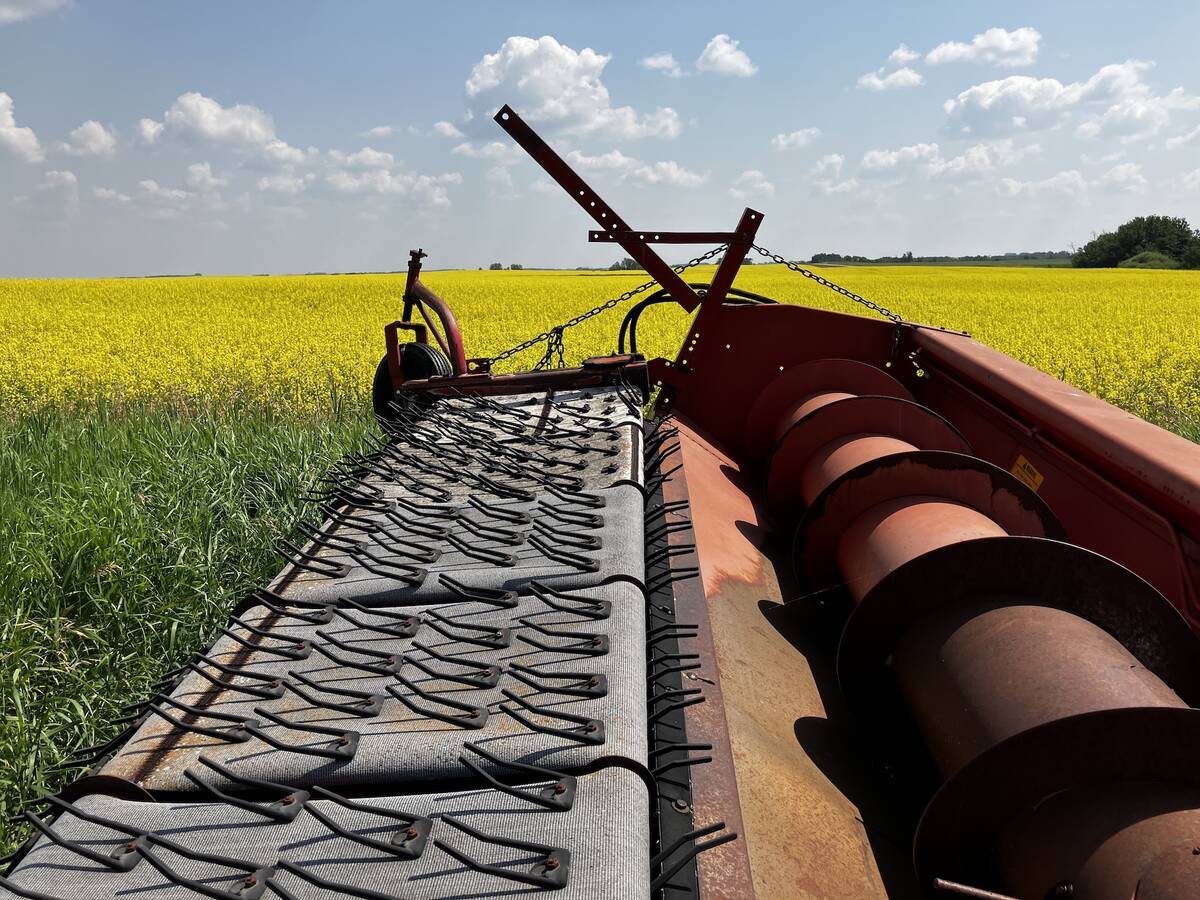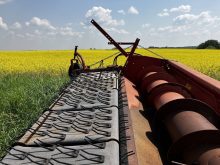* CBOT November soybeans dip to lowest level since Aug. 23
* U.S. rains may help moisture-stressed bean crop
* Corn retreats after early gains tied to USDA acreage data
* Wheat edges higher on short-covering
(Updates with closing prices, adds quotes)
By Julie Ingwersen
CHICAGO, Sept 17 (Reuters) - Chicago Board of Trade soybean
futures fell for a third straight session on Tuesday on
technical weakness and softening cash markets ahead of the U.S.
harvest, traders said.
Corn also eased reversing gains tied to government data
indicating a smaller U.S. planted area than the current official
Read Also

Stronger canola prices welcome surprise
Mid-November canola market holding above resistance based on durable demand, resulting in pleasantly higher canola prices for Canadian farmers
estimate, while wheat held firm on short-covering.
At the CBOT, November soybeans ended down 5-3/4 cents
at $13.42-1/2 per bushel after dipping to $13.32, the lowest
level since Aug. 23.
December corn settled down 2-1/2 cents at $4.54 per
bushel and December wheat ended up 1-3/4 cents at $6.43 a
bushel.
Soybeans led the declines, with sales accelerating after the
November contract fell below Monday's low. However, the
November contract pared losses and back months closed higher
amid worries that a late-summer dry spell could limit U.S.
yields.
"Beans are going to be highly variable this year, and I
think you are seeing that uncertainty in the marketplace," said
Jack Scoville, vice president with the Price Futures Group in
Chicago.
The bulk of the Midwest soybean crop is still maturing, but
harvest is under way in a few areas and cash basis bids have
been retreating sharply from historic highs set this summer.
"Harvest is picking up a little bit at a time," said Don
Roose, president of U.S. Commodities in West Des Moines, Iowa.
The U.S. Department of Agriculture did not release a
national figure for soybean harvesting in its weekly crop
progress report on Monday, but state reports showed the harvest
was 11 percent complete in Arkansas and 1 percent complete in
Indiana and Nebraska.
Additional price pressure stemmed from rain in parts of
Iowa, the top U.S. soybean state, and forecasts for more showers
later this week that could help crops in some areas.
"We are getting some moisture, and it's very late, but we do
have some late plantings that are going to benefit," Roose said.
Following a late-summer dry spell, 50 percent of the U.S.
soybean crop was rated in good to excellent condition as of
Sept. 15, down from 52 percent a week earlier, the USDA said.
Corn was rated 53 percent good to excellent compared with 54
percent a week ago. Twenty-two percent of the corn crop was
mature and 4 percent was harvested.
CORN FALLS, ERASING EARLY RALLY ON ACREAGE DATA
Corn futures fell for a fourth session on seasonal harvest
pressure and spillover weakness from soybeans. The USDA said the
U.S. corn harvest was 4 percent complete by Sunday, behind the
five-year average of 10 percent.
Corn retreated after rallying on U.S. government data that
indicated a smaller planted area than the current official
estimate.
The USDA's Farm Service Agency (FSA) on Tuesday said farmers
enrolled in crop subsidy programs reported planted acreage,
including failed acres, at 91.428 million acres for corn and
74.659 million for soybeans. The figures compare with the USDA's
official plantings estimates of 97.4 million acres for corn and
77.2 million for soybeans.
"The FSA numbers are behind all of the rally," said Roy
Huckabay with the Linn Group, a Chicago brokerage.
Not all farmers participate in U.S. government programs, so
the FSA acreage figures should fall below the USDA's official
estimates. But the difference in Tuesday's FSA figures and the
official estimates was larger than in recent years, a possible
sign that USDA eventually might lower its official acreage
figures.
However, analysts cautioned that the data was preliminary.
"These numbers shouldn't be viewed as the end-all or be-all
for acres and are only a part of the formula that USDA will use
to determine final acreage for this year," said Sterling Smith,
a futures specialist for Citigroup in Chicago.
Corn futures have struggled to rally since the USDA last
week raised its U.S. production forecast to a record high 13.8
billion bushels. The bearish supply outlook helped offset
concerns about acreage, Roose said.
"On corn, the feeling is, let's say you drop 3 million acres
on the top side. We are still going to have adequate supplies,"
Roose said.
WHEAT HOLDS FIRM
CBOT wheat ended firm on short-covering and recent export
demand. The USDA on Monday reported the amount of U.S. wheat
inspected for export in the latest week at more than 46 million
bushels, topping trade expectations.
"Demand has held up better than anyone expected. We are
doing some business," said Scoville.
Also, commodity funds hold a sizable net short position in
CBOT wheat, leaving the market open to bouts of short-covering.
"People are bearish and the market is not going down, so
they want to get out," Scoville said.
Prices at 3:06 p.m. CDT (2006 GMT)
LAST NET PCT YTD
CHG CHG CHG
CBOT corn 454.00 -2.50 -0.6% -35.0%
CBOT soy 1342.50 -5.75 -0.4% -5.4%
CBOT meal 428.80 -2.40 -0.6% 1.9%
CBOT soyoil 42.00 -0.13 -0.3% -14.6%
CBOT wheat 643.00 1.75 0.3% -17.4%
CBOT rice 1614.50 0.00 0.0% 8.6%
EU wheat 184.75 -0.25 -0.1% -26.2%
US crude 105.52 -1.07 -1.0% 14.9%
Dow Jones 15,530 35 0.2% 18.5%
Gold 1309.69 -3.70 -0.3% -21.8%
Euro/dollar 1.3358 0.0025 0.2% 1.2%
Dollar Index 81.1410 -0.1550 -0.2% 1.7%
Baltic Freight 1740 89 5.4% 148.9%
(Additional reporting by Naveen Thukral in Singapore and
Agnieszka Flak in Milan; editing by Jason Neely, Jim Marshall
and Diane Craft)
GRAINS-U.S. soybeans fall on technicals, harvest
By















